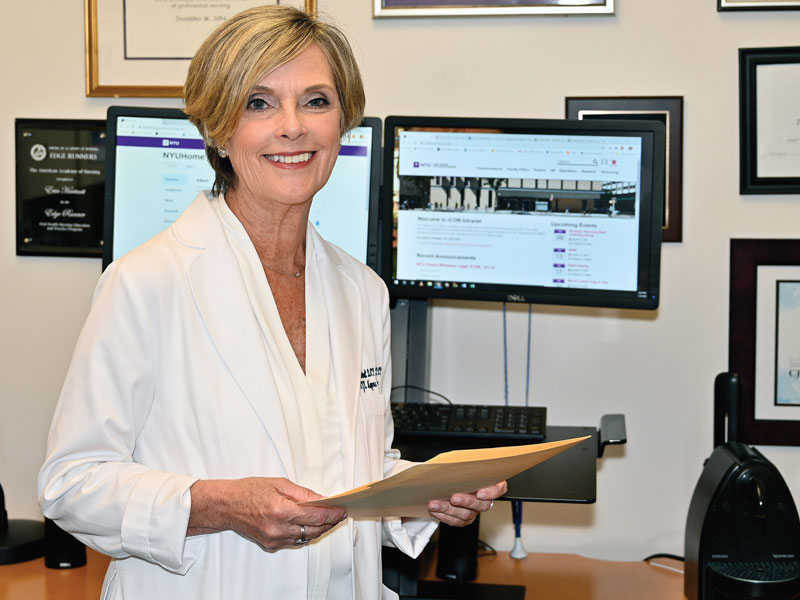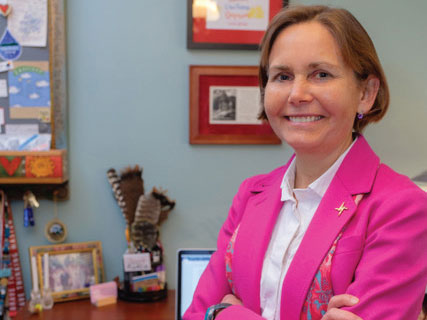The Value of Vigilance
Although society still hopes for that one big discovery to cure cancer, clinicians know that there’s already a tried and true method to give patients their best shot at survival: catching a diagnosis early or preventing one altogether.
According to the American Cancer Society (https://www.cancer.org/content/dam/cancer-org/research/cancer-facts-and-statistics/annual-cancer-facts-and-figures/2019/cancer-facts-and-figures-2019.pdf), nearly 42% of all newly diagnosed cancers in the United States may be avoidable. And early detection through recommended screening can help patients get treatment before their cancer advances, when it’s most successful.
As new evidence continually mounts for risk factors that can lead to cancer diagnoses, screening recommendations change and evolve over time, and it’s hard for the lay public to keep up. Oncology nurses are vital to the screening process, connecting patients with the latest information so they can make informed decisions about individualized screening plans. Through patient education, survivorship follow-up, and ongoing professional development, oncology nurses can help their patients, family members, and even their own communities stay up to date with evolving screening recommendations in practice.

Nursing’s Role in Screening and Prevention
To many oncology nurses, educating patients about prevention and screening may feel too little, too late in the process. But informing patients about current and new screening guidelines is crucial to limiting cancer risks, especially for secondary diagnoses.
“Nurses are essential in prevention and health promotion. They are patient educators and advocates, so it’s a critically important role to make sure patients are aware of screening recommendations and what they need for their specific situation,” ONS member Erin Hartnett, DNP, PPCNP-BC, CPNP, program director for New York University’s Oral Health Nursing Education and Practice in New York City and member of the New York City ONS Chapter, says. “By educating patients about new and evolving recommendations, nurses can promote informed decision making, allowing patients to have the information they need to decide whether they want to participate in cancer screening or which might be best for them. Most patients aren’t even aware of the screenings available and look to their healthcare professionals to help guide them.”

ONS member Aurelie Cormier, RN, MS, ANP-BC, nurse practitioner at W.E.L.L.N.E.S.S. Parenting in Needham, MA, and member of the Boston ONS Chapter, says that nurses must work with patients to understand their individual cancer risk and tailor education to screening recommendations based on their personal situation.
“Patients with no understanding of screening, prevention, or cancer risk factors need information that empowers them to help reduce their cancer risks or change poor lifestyle habits,” Cormier says. “But as nurses, our primary responsibility with screening recommendations is to review what risk factors a patient has based on their personal history, lifestyle, and family history. With that information, we can point out and review which strategies will be most helpful to them, decide whether they are at average risk or high risk for certain cancers, and outline what their screening recommendations should be.”
Best Practices for Screening Strategies
With the vast availability of screening information online and in the news, patients are savvier than ever before. But not everyone has the same level of health literacy regarding when and for which cancers to screen, and that’s where nurses can intervene.
“To help patients understand new screening recommendations in practice, I always ask them if they’ve had any screening to that point and what they know about the new screening guidelines,” Cormier says. “I’ve found that some patients are already aware and on board with the process—sometimes they know more than we do. In that case, I always reinforce their knowledge, encourage them to continue being proactive, and offer any ideas to help keep them healthy and avoid risk. For patients who don’t know what to do, I always look at their individual risks. I ask them about factors based on their medical or family history, and I try to understand their high-risk health habits. Before we part ways, I like to provide them with patient education materials like a brochure or printout that they can take home.”
As the evidence base grows and more is discovered about what influences the development of cancer, screening recommendations are updated to meet public health needs. Staying current on the latest trends in screening and prevention is daunting, but it’s a key component of successful patient-centered care.
“The most important thing nurses need to do is stay informed,” Hartnett says. “Nurses working in another specialty diagnosis may not be aware of new screening recommendations for other cancers. It’s really up to nurses to know where to find those screening resources and to be sure that they’re up to date to meet patient needs.”
Sharing New Screening Recommendations
Cormier and Hartnett cite organizations like the U.S. Preventive Services Task Force and National Comprehensive Cancer Network that provide regularly updated screening guidelines for many disease types. But nurses can also stay up to date by reading peer-reviewed journals and enrolling in email subscription lists that share the latest screening recommendations. Remaining vigilant for new updates and communicating them with the cancer care team are crucial.
“At Massachusetts General Hospital, we had a nursing practices floor committee where we assigned different people to bring new practice information to the team. It was something we did once a month, and we would share some of the best practices based on current topics or issues that came up. Units can designate somebody on the floor to collect new screening information and share it with the team at the meeting,” Cormier says. “Clinical nurse specialists could also gather that information and put it up on the wall where nurses eat lunch, on the way to the restroom, or in other common areas that nurses frequent. You have to come up with all kinds of creative strategies to get that information out there.”
Cormier also emphasizes the importance of reinforcing new screening recommendations with patients. Providing multiple touchpoints for screening education is vital.
“In the office, you can make posters or one-page patient education sheets outlining new cancer screening recommendations. I know if I hear something, I’m likely to forget it, and a lot of patients will better remember something that they see rather than something they hear,” Cormier says. “A lot of times when patients come in, they’re so nervous about what they’re there for that they only remember the first thing you say and nothing else. If they have something in writing, they’re more likely to remember it. Having a poster on the wall can be helpful, or a little brochure in the waiting room that they can take with them is invaluable.”
Screening Into Survivorship
The transition from active treatment to survivorship can ignite a new sense of anxiety for patients who are hypervigilant for recurrent or secondary diagnoses. Nurses must empower patients to make informed decisions and follow appropriate screening recommendations.
“If a patient isn’t referred to a specific survivorship program or given a written survivorship care plan, they’re left to their own devices to understand future screenings,” Harnett says. “It’s crucial to have care plans in place that include clear screening information and where to find updated screening guidelines. Nurses can explain and outline that content. Including screening recommendations in the care plan will take the guesswork out of the process for patients.”
“We are the holistic practitioners on the healthcare team,” Cormier adds. “As patients navigate survivorship, nurses can review what’s important to them in their lives, what their health habits are, and what strategies they can tune up to give themselves the best chance of living a longer, better life with lower cancer risks. Nurses can be health coaches and patient champions, and we can empower them to contribute to their own survival—now and in the future.”
Advocating for Prevention
Cormier and Hartnett say that screening is just one part of the prevention conversation. Reinforcing healthy habits and working to lower cancer risk also go a long way to reduce the possibility of future diagnoses.
“An estimated 30%–50% of all cancers are preventable, and many are caused by unhealthy lifestyle choices like smoking, poor diet, no exercise, sun exposure, and drug and alcohol abuse,” Hartnett says. “But I also think the most important cancer prevention nurses can do is educate parents about getting the human papillomavirus (HPV) vaccine for their 11- to 12-year-olds before they are exposed to HPV. It is our only anticancer vaccine and can prevent six types of cancer directly associated with HPV. Yet only 51% of our teens are fully vaccinated against HPV. It is essential for nurses to promote awareness. The HPV vaccine can be lifesaving for patients.”
Cormier supports a team-based approach to screening and prevention. Coordination is key to ensure patients are connected to the information, resources, and professionals they need, she says.
“It takes a team to tackle a patient’s cancer treatment, and it must be a team that addresses screening and prevention. Nurses are experts at the science and heart of health care, and we see our patients in their wholeness,” Cormier says. “We must coordinate with nutrition colleagues, physical therapists, social workers, and other nursing professionals to give patients the resources they need. In that way, nurses can make a huge difference.”
Ultimately, as experts in cancer screening, prevention, and patient-centered care, nurses are one of the primary healthcare professionals responsible for ensuring that patients understand their risk for potential cancer diagnoses. Education and tailored support are critical for patients to adhere to evolving screening recommendations. As scientific evidence continues to grow, new screening guidelines will come to practice, and nurses must help their patients understand how to act on the information. The easiest cancer to cure is no cancer at all.
